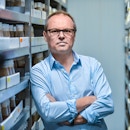The Pressure to Sleep
- Speaker
-
 Gero Miesenböck, M.D.Waynflete Professor of Physiology Director, Centre for Neural Circuits and Behaviour, University of Oxford
Gero Miesenböck, M.D.Waynflete Professor of Physiology Director, Centre for Neural Circuits and Behaviour, University of Oxford
Presidential Lectures are free public colloquia centered on four main themes: Biology, Physics, Mathematics and Computer Science, and Neuroscience and Autism Science. These curated, high-level scientific talks feature leading scientists and mathematicians and are intended to foster discourse and drive discovery among the broader NYC-area research community. We invite those interested in the topic to join us for this weekly lecture series.
Sleep is vital and universal, but its biological functions remain unknown. In this lecture, Gero Miesenböck will present clues to the mystery of sleep by examining how the brain responds to sleep loss.
He will describe his work in fruit flies that showed that rising sleep pressure activates dedicated sleep-control cells. The activity of those cells fluctuates due to the antagonistic regulation of two potassium conductances: voltage-gated Shaker and the leak channel Sandman. Insight into the sleep need-dependent regulation of these ion channels is beginning to furnish a molecular interpretation of sleep pressure, uncover the cellular processes responsible for its accumulation and discharge, and suggest a physiological role for sleep in protecting neuronal membranes against oxidative damage.
